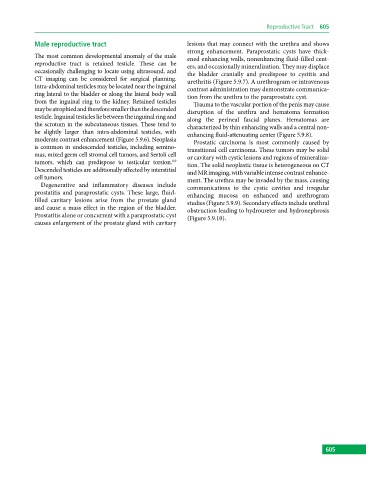Page 615 - Atlas of Small Animal CT and MRI
P. 615
Reproductive Tract 605
Male reproductive tract lesions that may connect with the urethra and shows
strong enhancement. Paraprostatic cysts have thick-
The most common developmental anomaly of the male ened enhancing walls, nonenhancing fluid‐filled cent-
reproductive tract is retained testicle. These can be ers, and occasionally mineralization. They may displace
occasionally challenging to locate using ultrasound, and the bladder cranially and predispose to cystitis and
CT imaging can be considered for surgical planning. urethritis (Figure 5.9.7). A urethrogram or intravenous
Intra‐abdominal testicles may be located near the inguinal contrast administration may demonstrate communica-
ring lateral to the bladder or along the lateral body wall tion from the urethra to the paraprostatic cyst.
from the inguinal ring to the kidney. Retained testicles Trauma to the vascular portion of the penis may cause
may be atrophied and therefore smaller than the descended disruption of the urethra and hematoma formation
testicle. Inguinal testicles lie between the inguinal ring and along the perineal fascial planes. Hematomas are
the scrotum in the subcutaneous tissues. These tend to characterized by thin enhancing walls and a central non-
be slightly larger than intra‐abdominal testicles, with enhancing fluid‐attenuating center (Figure 5.9.8).
moderate contrast enhancement (Figure 5.9.6). Neoplasia Prostatic carcinoma is most commonly caused by
is common in undescended testicles, including semino- transitional cell carcinoma. These tumors may be solid
mas, mixed germ cell stromal cell tumors, and Sertoli cell or cavitary with cystic lesions and regions of mineraliza-
tumors, which can predispose to testicular torsion. tion. The solid neoplastic tissue is heterogeneous on CT
8,9
Descended testicles are additionally affected by interstitial and MR imaging, with variable intense contrast enhance-
cell tumors. ment. The urethra may be invaded by the mass, causing
Degenerative and inflammatory diseases include communications to the cystic cavities and irregular
prostatitis and paraprostatic cysts. These large, fluid‐ enhancing mucosa on enhanced and urethrogram
filled cavitary lesions arise from the prostate gland studies (Figure 5.9.9). Secondary effects include urethral
and cause a mass effect in the region of the bladder. obstruction leading to hydroureter and hydronephrosis
Prostatitis alone or concurrent with a paraprostatic cyst (Figure 5.9.10).
causes enlargement of the prostate gland with cavitary
605

